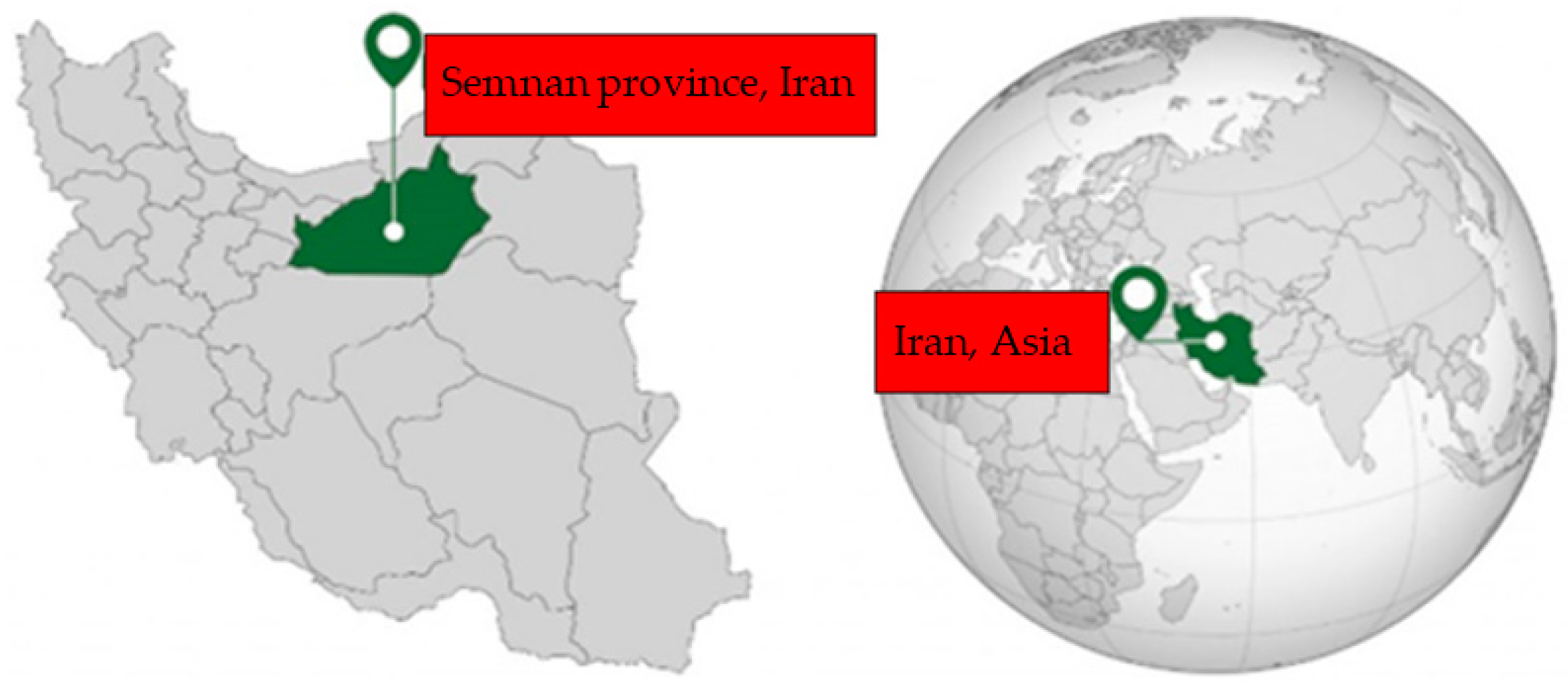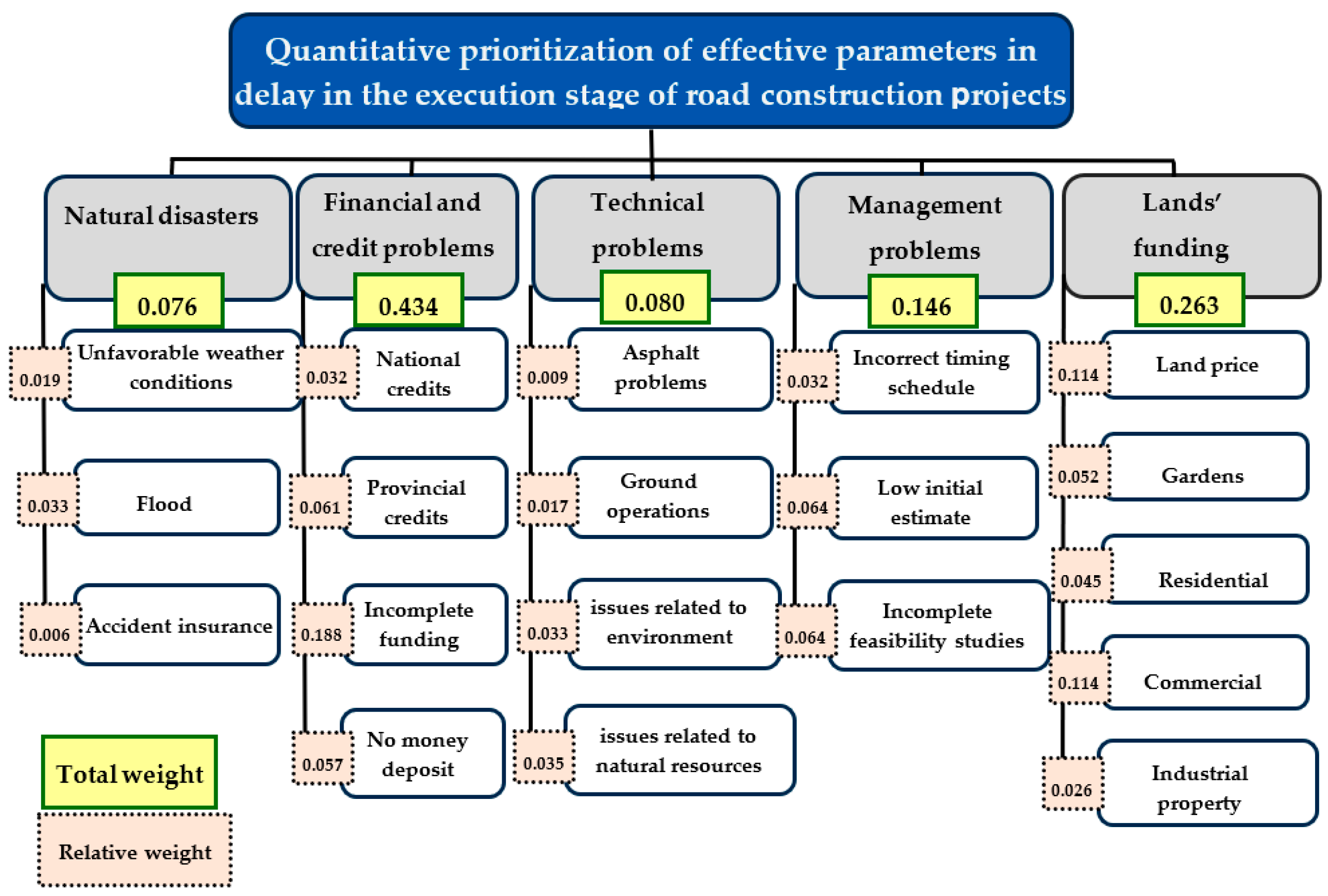1. Introduction
The delay issue exists in most road construction projects [
1]. The Oxford English Dictionary defines delay as “a period of time when someone or something has to wait because of a problem that makes something slow or late” [
2]. Increasing the time beyond the planned amount has adverse effects on the project’s success in terms of cost, quality, and time [
3,
4,
5,
6,
7]. Delays can occur in any construction project, but their magnitude varies from project to project [
8]. When the project schedule is based on a reasonable time, project uncertainties that affect success will be based on two hypotheses of probability and possibility [
9]. To overcome this problem, evaluation of the delay risks is inevitable.
The present study has focused on delay factors in the execution stage of road construction projects. The project’s lifecycle has five stages. These steps include the initial stage, the planning stage, the design stage, the execution stage, and the final stage [
10]. However, this study has only focused on the execution stage.
The execution stage is the longest and the costliest stage of the project’s lifecycle. Moreover, it is the riskiest part of project management [
10]. In particular, this is the case if the project management team is not correctly formed or risk management practices are not implemented at all stages of the project lifecycle [
11]. Since construction projects are very complex, delay problems occur for a variety of reasons. It is essential to control factors for the successful completion of the project. Although the delay cannot be avoided, recognizing its reasons and the necessary precautions can reduce the effects.
Rivera et al. [
1] have conducted a study to investigate causes of delay in road construction projects across 25 developing countries. From their view, a weak construction manager, incorrect planning/scheduling, influence on people’s land alongside the road construction project, poor communication between construction groups, frequent changes in design, shortage of equipment, force majeure, contract modification, delays in execution of progress billing, lack of construction materials, delayed payment to contractors, and poor labor productivity are the most important causes of delay.
Ragunath and Hamed [
12] identify the ten principal reasons for delay in construction projects. They are: shortage of building material in the market, material cost increment, delay in material delivery, profitability decrement derived from the financial problem, lack of workforce, the delay in fulfilling the work by the owner, change in material quality, weak presenting of the work and workforce efficiency, banking limitation, and impermissible workforce.
Venkateswaran and Murugasan [
13] identify the five principal reasons for delay as land acquisition, many stakeholders, displacement of network, legal requirements, and claims and disputes.
Awari et al. [
14] consider weak management, the employer’s financial payment to the contractor, inefficient planning and timing of the construction project, the disagreement between the various sides, the shortage of material, and the shortage of workforce as the important reasons for delay.
Pourrostam and Ismail [
15] have identified the reasons for delay in the construction projects of Iran by the questionnaire and consider the weak management of the site, contractor financial problems, and the change order by the employer during the construction period the most important reasons for delay. They have evaluated the prioritization of reasons for delay based on the relative importance index.
According to the literature review, it can be expressed that:
The considered factors in the literature only consider one level of the delay reasons, whereas these factors are related to other factors;
Although researchers have highlighted many factors of increased time, a large number of them have not suggested possible control measures for these factors.
Therefore, identifying the root causes of delays, qualitative prioritizing, quantitative prioritizing, and providing solutions to reduce their impact on road construction projects from a risk management perspective, are the objectives of this research. Although researchers have highlighted many factors of increased time, a large number of them have not suggested possible control measures for these factors [
16,
17].
3. Data Analysis
Library resources and the experts’ opinion finalized a list of the main criteria and subcriteria of the risks. The qualitative prioritization of delay risks is shown by the cause and effect (Ishikawa) chart (
Figure 2). The parameters effective on delay in the road construction projects are divided into two main groups of internal and external factors by the experts’ opinion. For internal factors, their origin is of the project itself, and the external factors apply to the project through the environment.
3.1. The Lands’ Funding
To build a road, the lands’ funding must be complete. According to the ownership and various uses of the road environment lands, the lands’ funding will increase the construction time. Therefore, the delay due to lands’ funding has been categorized into subsections such as land price, gardens, residential, commercial, and industrial property, such that each of them has their problems.
3.2. Management Problems
This part of delay was derived from the project studies phase and includes an incorrect timing schedule, a low initial estimate, and incomplete feasibility studies. If presenting the management analyses of the plan is performed correctly, this problem will arise less in the execution stage.
3.3. Technical Problems
This type of problem is related to the used material for the execution stage of the road construction projects that includes asphalt problems, problems related to the ground operations, issues related to environment organization, and issues related to natural resources organization.
3.4. Financial and Credit Problems
The financial problems are more related to allocation and credits. The credits section can be divided into the national credits and provincial credits, and the allocation section problems include incomplete funding and no money deposit. The financial issues weaken the contractor’s economic power, and the execution time will increase.
3.5. Natural Disasters
Natural disasters are a part of the out-of-project factors that apply to the project from the environment. These factors include unfavorable weather conditions, flood, and accident insurance.
By collecting expert opinions in the form of linguistic statements, a pairwise matrix was obtained to quantitatively prioritize the risks. Then, the pairwise comparisons’ matrix about the main criteria and subcriteria has been accumulated. Six pairwise comparison matrixes have been made to collect the experts’ opinions in performing the pairwise comparison between the hierarchical elements. The first pairwise comparison has been made between the main criteria effective on the hierarchical first row. The various risks are compared with each other to specify their effect on the execution stage of the road projects. In the following, the impact of subcriteria on the delay and the level of their impact on the main criteria have been compared.
Table 3,
Table 4,
Table 5,
Table 6,
Table 7 and
Table 8 show the pairwise comparisons matrix for the main criteria and subcriteria.
For ensuring opinions’ consistency in all the pairwise comparison matrixes, the inconsistency rate was calculated. The inconsistency rate for the main criteria is equal to
The financial and credit risk identified as the most critical risk and lands’ funding, management problems, technical problems, and natural disasters are in the next stage.
In the lands’ funding group, the land price and gardens have the most important value, and the residential, commercial, and industrial areas are in the subsequent steps.
Incomplete feasibility studies, incorrect timing schedule, and low initial estimate have risks, respectively, in the management problems group.
Issues related to the natural resources, issues related to environment, the ground operations, and the asphalt problems have the most risk in the technical problems group.
In the financial and credit group, the incomplete funding, the provincial credits, no money deposit, and the national credits have the most amount of risk.
In the natural disasters group, the flood, the unfavorable weather conditions, and the accident insurance have importance, respectively.
The inconsistency rate of the main criteria and subcriteria was less than 0.1. Therefore, the questionnaires are reliable and Saaty opinion is confirmed [
21]. Quantitative assessment of risks indicates that financial and credit problems with a weight of 0.434 are the most important, and in the next ranks are lands’ funding with the weight of 0.263, management problems with the weight of 0.146, technical problems with a weight of 0.080, and natural disasters with an overall weight of 0.076.
The normalized weight has been calculated for each of the existing elements in the hierarchy by the Expert Choice software (
Figure 3). In general, the prioritizing shows that the incomplete funding with 0.188 weight is specified as the most critical risk. Land price and gardens with 0.114 weight are in the second rank, and the incomplete feasibility studies and incorrect timing schedule with 0.064 are in the third rank. In the following, provincial credits with 0.061, no money deposit with 0.057, residential areas with 0.052, commercial areas with 0.045, issues related to the natural resources with 0.035, issues related to environment with 0.033, flood with 0.033, low initial estimate with 0.032, national credits with 0.032, industrial property with 0.026, unfavorable weather conditions with 0.019, ground operations with 0.017, asphalt problems with 0.009, and accident insurance with 0.006 have the subsequent ranks.
5. Conclusions
Due to the importance of delays, it is necessary to investigate and analyze their factors. Although the delay cannot be avoided, it can be reduced with the required precautions. In this study, we investigate delays from a risk management perspective that offers a robust framework for delay control. This framework prioritizes risks, analyzes critical criteria, provides solutions to reduce delays, and helps improve the construction process.
In this research, a framework has been presented to identify and prioritize the risks of delay for the road construction projects with the AHP method. The framework discusses delays from a system management perspective and the group AHP method serves as a tool for studying and decreasing the inconsistencies rate determined by the experts. The Ishikawa chart has provided a powerful tool for identifying and prioritizing qualitative risks, and the AHP method has provided a powerful method for quantitative risks. The offered framework for a road construction project in the execution stage shows how the framework can help the decision-makers by implementing all risk management processes.
Research results show that financial and credit problems with a weight of 0.434, lands’ funding with a weight of 0.263, management problems with a weight of 0.146, technical problems with a weight of 0.080, and natural disasters with an overall weight of 0.076 are the most important, respectively. We determine the relative weight of incomplete funding with a weight of 0.188 in the first place, gardens and land price with 0.114 in the second place, and incorrect timing schedule and incomplete feasibility studies with 0.064 in the third place; provincial credits with 0.061, no money deposit with 0.057, residential areas with 0.052, commercial areas with 0.045, issues related to natural resources with 0.035, and issues related to environment and flood with 0.033, respectively. Low initial estimate and national credits with 0.032, industrial property with 0.026, unfavorable weather conditions with 0.091, ground operations with 0.017, asphalt problems with 0.009, and accident insurance with 0.006 relative weight with relative ratings next are the quantitative risk assessments.
We investigated delays from a risk management perspective and showed that it is a powerful method for prioritizing delays because it provides a plan to respond to the critical criteria, and this plan does not exist in other methods. However, in the prioritization, the risks that are of high importance may be low cost in the project. Whereas the risks that are of low importance may be very costly to the project. Therefore, further research is needed to develop a method to quantify the cost-effectiveness of risks.















